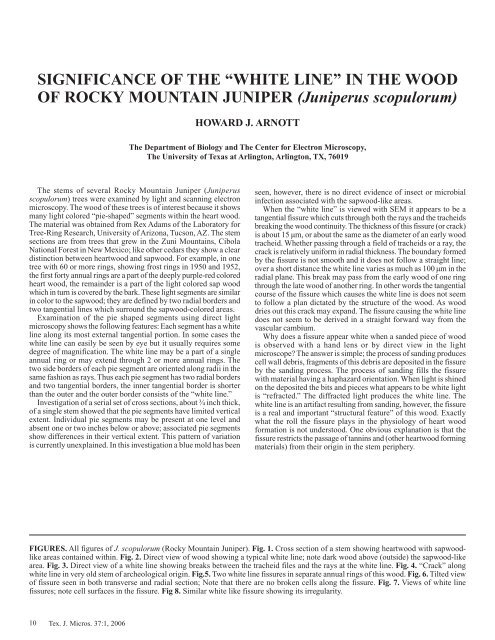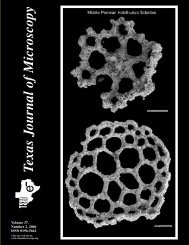Texas Journal of Microscopy Texas Journal of Microscopy
Texas Journal of Microscopy Texas Journal of Microscopy
Texas Journal of Microscopy Texas Journal of Microscopy
Create successful ePaper yourself
Turn your PDF publications into a flip-book with our unique Google optimized e-Paper software.
SIGNIFICANCE OF THE “WHITE LINE” IN THE WOOD<br />
OF ROCKY MOUNTAIN JUNIPER (Juniperus scopulorum)<br />
FIGURES. All figures <strong>of</strong> J. scopulorum (Rocky Mountain Juniper). Fig. 1. Cross section <strong>of</strong> a stem showing heartwood with sapwoodlike<br />
areas contained within. Fig. 2. Direct view <strong>of</strong> wood showing a typical white line; note dark wood above (outside) the sapwood-like<br />
area. Fig. 3. Direct view <strong>of</strong> a white line showing breaks between the tracheid files and the rays at the white line. Fig. 4. “Crack” along<br />
white line in very old stem <strong>of</strong> archeological origin. Fig.5. Two white line fissures in separate annual rings <strong>of</strong> this wood. Fig. 6. Tilted view<br />
<strong>of</strong> fissure seen in both transverse and radial section; Note that there are no broken cells along the fissure. Fig. 7. Views <strong>of</strong> white line<br />
fissures; note cell surfaces in the fissure. Fig 8. Similar white like fissure showing its irregularity.<br />
10 Tex. J. Micros. 37:1, 2006<br />
HOWARD J. ARNOTT<br />
The Department <strong>of</strong> Biology and The Center for Electron <strong>Microscopy</strong>,<br />
The University <strong>of</strong> <strong>Texas</strong> at Arlington, Arlington, TX, 76019<br />
The stems <strong>of</strong> several Rocky Mountain Juniper (Juniperus<br />
scopulorum) trees were examined by light and scanning electron<br />
microscopy. The wood <strong>of</strong> these trees is <strong>of</strong> interest because it shows<br />
many light colored “pie-shaped” segments within the heart wood.<br />
The material was obtained from Rex Adams <strong>of</strong> the Laboratory for<br />
Tree-Ring Research, University <strong>of</strong> Arizona, Tucson, AZ. The stem<br />
sections are from trees that grew in the Zuni Mountains, Cibola<br />
National Forest in New Mexico; like other cedars they show a clear<br />
distinction between heartwood and sapwood. For example, in one<br />
tree with 60 or more rings, showing frost rings in 1950 and 1952,<br />
the first forty annual rings are a part <strong>of</strong> the deeply purple-red colored<br />
heart wood, the remainder is a part <strong>of</strong> the light colored sap wood<br />
which in turn is covered by the bark. These light segments are similar<br />
in color to the sapwood; they are defined by two radial borders and<br />
two tangential lines which surround the sapwood-colored areas.<br />
Examination <strong>of</strong> the pie shaped segments using direct light<br />
microscopy shows the following features: Each segment has a white<br />
line along its most external tangential portion. In some cases the<br />
white line can easily be seen by eye but it usually requires some<br />
degree <strong>of</strong> magnification. The white line may be a part <strong>of</strong> a single<br />
annual ring or may extend through 2 or more annual rings. The<br />
two side borders <strong>of</strong> each pie segment are oriented along radii in the<br />
same fashion as rays. Thus each pie segment has two radial borders<br />
and two tangential borders, the inner tangential border is shorter<br />
than the outer and the outer border consists <strong>of</strong> the “white line.”<br />
Investigation <strong>of</strong> a serial set <strong>of</strong> cross sections, about ¾ inch thick,<br />
<strong>of</strong> a single stem showed that the pie segments have limited vertical<br />
extent. Individual pie segments may be present at one level and<br />
absent one or two inches below or above; associated pie segments<br />
show differences in their vertical extent. This pattern <strong>of</strong> variation<br />
is currently unexplained. In this investigation a blue mold has been<br />
seen, however, there is no direct evidence <strong>of</strong> insect or microbial<br />
infection associated with the sapwood-like areas.<br />
When the “white line” is viewed with SEM it appears to be a<br />
tangential fissure which cuts through both the rays and the tracheids<br />
breaking the wood continuity. The thickness <strong>of</strong> this fissure (or crack)<br />
is about 15 µm, or about the same as the diameter <strong>of</strong> an early wood<br />
tracheid. Whether passing through a field <strong>of</strong> tracheids or a ray, the<br />
crack is relatively uniform in radial thickness. The boundary formed<br />
by the fissure is not smooth and it does not follow a straight line;<br />
over a short distance the white line varies as much as 100 µm in the<br />
radial plane. This break may pass from the early wood <strong>of</strong> one ring<br />
through the late wood <strong>of</strong> another ring. In other words the tangential<br />
course <strong>of</strong> the fissure which causes the white line is does not seem<br />
to follow a plan dictated by the structure <strong>of</strong> the wood. As wood<br />
dries out this crack may expand. The fissure causing the white line<br />
does not seem to be derived in a straight forward way from the<br />
vascular cambium.<br />
Why does a fissure appear white when a sanded piece <strong>of</strong> wood<br />
is observed with a hand lens or by direct view in the light<br />
microscope? The answer is simple; the process <strong>of</strong> sanding produces<br />
cell wall debris, fragments <strong>of</strong> this debris are deposited in the fissure<br />
by the sanding process. The process <strong>of</strong> sanding fills the fissure<br />
with material having a haphazard orientation. When light is shined<br />
on the deposited the bits and pieces what appears to be white light<br />
is “refracted.” The diffracted light produces the white line. The<br />
white line is an artifact resulting from sanding, however, the fissure<br />
is a real and important “structural feature” <strong>of</strong> this wood. Exactly<br />
what the roll the fissure plays in the physiology <strong>of</strong> heart wood<br />
formation is not understood. One obvious explanation is that the<br />
fissure restricts the passage <strong>of</strong> tannins and (other heartwood forming<br />
materials) from their origin in the stem periphery.




